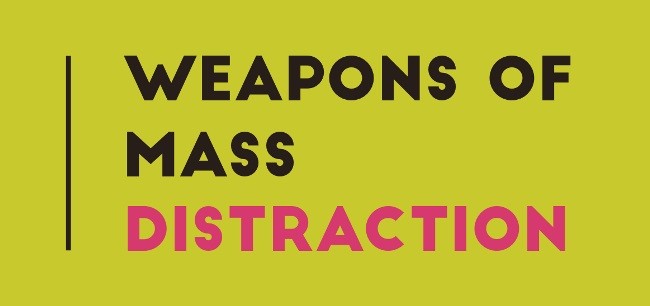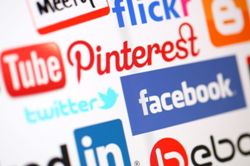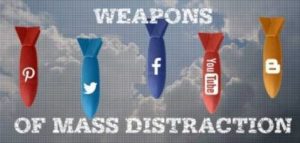BATTLING THE WEAPONS OF MASS DISTRACTION (WMD)

The smartphone is the world’s greatest weapon of mass distraction (WMD), owing to the magnitude of the distraction epidemic and cyber-mania it has unleashed on us. Day and night our mobile phones, and other devices, buzz, ping, beep, hum, drone, croon, howl their way into our attention. Our brains are limited in their ability to pay attention. When we spend that extra hour on social media, we pay for it with our sleep. This results in stockpiling of sleep-debt, as too much social media time leads to less sleep. Air Marshal B.S. Dhanoa during the Aerospace Medicine Conference held recently in Bangalore on 14, September 2018 acknowledged that sleep deprivation caused by spending too much time on social media was the cause behind the crash of MIG 21 Bison fighter aeroplane in 2013 at Uttarlai in Rajasthan. Recent studies confirm links between smartphone/ social media addiction and increased levels of anxiety, depression, poor sleep quality, and increased risk of vehicle accidents or death.  Sleep deprivation and stress can have ripple effects on a population, leading to a greater incidence of workplace accidents and suicides. When I was on deputation with CISF( Central Industrial Security Force) we found a peculiar phenomenon of escalation in suicides amongst constables when the mobile phones become affordable to them. Bad news from their remote villages, which used to take days, was now reaching them instantaneously and throwing their coping mechanisms out of gear. Mobile phones apart from work-related stress is a conduit for a significant amount of stress for police personnel. Recognising the need to combat stress , Tamilnadu became the first state in the entire country on September, 20, 2018, to launch a comprehensive wellness programme called the ‘Police well-being training’ in collaboration with National Institute of Mental Health and Neuro Sciences (Nimhans), Bengaluru, to help the police personnel battle all forms of stress including digital stress and improve their mental well being.
Sleep deprivation and stress can have ripple effects on a population, leading to a greater incidence of workplace accidents and suicides. When I was on deputation with CISF( Central Industrial Security Force) we found a peculiar phenomenon of escalation in suicides amongst constables when the mobile phones become affordable to them. Bad news from their remote villages, which used to take days, was now reaching them instantaneously and throwing their coping mechanisms out of gear. Mobile phones apart from work-related stress is a conduit for a significant amount of stress for police personnel. Recognising the need to combat stress , Tamilnadu became the first state in the entire country on September, 20, 2018, to launch a comprehensive wellness programme called the ‘Police well-being training’ in collaboration with National Institute of Mental Health and Neuro Sciences (Nimhans), Bengaluru, to help the police personnel battle all forms of stress including digital stress and improve their mental well being.
In 1988 when I left home to pursue my PhD in New Delhi, I kept in touch with my parents who lived in Hyderabad once a week on expensive landline calls and sent letters that arrived a week later. Quite often, in order to get in touch with my parents, I had to walk more than a mile, stand in the queue of the STD booth, sometimes for more than an hour, and incur a monthly expenditure on the telephone bills which far surpassed my monthly mess bill. Quite recently, when my daughter left abroad for higher studies, I and my wife were in continuous contact with her, through FaceTime, at the drop of a hat, without spending a dime. Technology has shrunk the distance, as well as transformed the experience of making a call, into a hugely easy and pleasurable one. Technology is neutral, it isn’t morally good or bad. Social media platforms can be intended to promote rich social connections like the FaceTime, or they can be contrived to keep the user addicted to the social site, by delivering recurrent dopamine hits like the Facebook. Some social media platforms activate the same parts of the brain as cocaine. Most developers of Social Media platforms have been intentionally devising and designing sites to keep their users perpetually addicted and hooked. As a result, most Social media platforms are taking a heavy toll on our lives by leaving us mentally frayed, tattered, distracted and drained.
Social media platforms like Facebook, Instagram, Twitter, etc are tantamount to huge dopamine reserves. We experience a biff of dopamine, whenever we get a like on our Facebook or a whack of dopamine, whenever someone comments on our Instagram post. Social media platforms are therefore turning us into dopamine junkies. More and more social media users are digging into them, to receive dopamine jolts to the brain much like the bonks received by the addicts of cocaine or nicotine. As a matter of fact, Facebook, Snapchat, and Instagram leverage the very same neural networks used by slot machines and cocaine to keep us using their products as much as possible.
 Social media addiction eventually messes up our brain chemistry heading up to depression, anxiety, sleep debt, etc. Dopamine the pleasure or reward neurotransmitter is excitatory, while on the contrary serotonin and GABA the inhibitory neurotransmitters are also crucial. Both dopamine and serotonin play a role in our sleep-wake cycle. There are substantial signs that point towards the participation of the neurotransmitter dopamine in wakefulness. Things that enhance the levels of dopamine in the brain, like social media, slot machines, drugs like cocaine, amphetamine, make a contribution to feelings of wakefulness. Raising dopamine in the brain via genetic modification, by getting rid of the dopamine transporter in a mouse, produced a mouse that suffered from insomnia. People with Parkinson’s disease seem to suffer from excessive daytime sleepiness due to low dopamine levels. Serotonin and GABA on the flip side are involved in sleep onset and production of sleep hormone melatonin, which could be imbalanced by excess dopamine from social media fixation. The blue light emitted from the screens of the devices, also play havoc with the nocturnal release of the hormone melatonin, disrupting our circadian rhythms. The two other major players in the stress response which buildup with social media usage are stress hormones, adrenaline and cortisol. Adrenaline increases the heart rate and blood pressure while cortisol causes blood sugar to increase. A study out of the University of Queensland in Australia, published in “The Journal of Social Psychology”, found that taking a break from Facebook, even for periods less than a week, could actually lower the levels of the stress hormone cortisol in a person’s body.
Social media addiction eventually messes up our brain chemistry heading up to depression, anxiety, sleep debt, etc. Dopamine the pleasure or reward neurotransmitter is excitatory, while on the contrary serotonin and GABA the inhibitory neurotransmitters are also crucial. Both dopamine and serotonin play a role in our sleep-wake cycle. There are substantial signs that point towards the participation of the neurotransmitter dopamine in wakefulness. Things that enhance the levels of dopamine in the brain, like social media, slot machines, drugs like cocaine, amphetamine, make a contribution to feelings of wakefulness. Raising dopamine in the brain via genetic modification, by getting rid of the dopamine transporter in a mouse, produced a mouse that suffered from insomnia. People with Parkinson’s disease seem to suffer from excessive daytime sleepiness due to low dopamine levels. Serotonin and GABA on the flip side are involved in sleep onset and production of sleep hormone melatonin, which could be imbalanced by excess dopamine from social media fixation. The blue light emitted from the screens of the devices, also play havoc with the nocturnal release of the hormone melatonin, disrupting our circadian rhythms. The two other major players in the stress response which buildup with social media usage are stress hormones, adrenaline and cortisol. Adrenaline increases the heart rate and blood pressure while cortisol causes blood sugar to increase. A study out of the University of Queensland in Australia, published in “The Journal of Social Psychology”, found that taking a break from Facebook, even for periods less than a week, could actually lower the levels of the stress hormone cortisol in a person’s body.
The impact smartphones have had after they showed up in our lives, has been a long way off from good. Paradoxically, we are busy but ineffective at the same time. Although we are connected to people on devices, we feel isolated and lonely all the time. On the surface, connectivity afforded by technology appears to have enhanced our sense of freedom, but the chains of technology, in reality, have insidiously enslaved and shackled us to the electronic screens and imprisoned us there. The problem is not with our smartphones themselves. Our problem stems from our relationships with our devices. Therefore, it’s not about waging a war against WMD, nor is it about securing a truce with WMD . In the long run, it is all about managing and curtailing the manner in which technology is used, so that it becomes an ally, not an enemy. As a first step, we should keep an eye on our online activity by installing apps like Rescuetime, Checky, Moment etc and turn off the notifications on the phone to monitor and reduce consumption of technology. This will help us establish boundaries between our online and offline lives. Embarking on digital detox sporadically could also go a long way by helping us become aware of the joys and wonders available to us outside the connected world. Setting up phone free periods during the day, not reaching for the mobile until after breakfast and switching off the smartphone two hours before bed could vastly improve your quality of sleep as the impact of blue light on the sleep would be minimised. Substituting social media time with face-to-face activities with family and friends who support and care, setting aside the phone while socialising, as well as during dinner/meal times, reading, gymming times etc are other strategies which could be extremely helpful. Dropping out and going offline enabled me to get back to reading voraciously, and to writing. In one study, 95% of those interviewed said that their mood improved a great deal after putting down the phones to spend time outside in nature, changing from depressed, stressed, and anxious to more calm and balanced.
The other strategies that have worked extremely well for me is a productivity hack called ‘batching’ proposed by Tim Ferriss, in his best selling book “The 4-Hour Workweek” where predetermined times are set, twice or thrice a day to check and respond to emails ,texts, or scroll through Instagram or interact on Facebook. Tim uses automatic responders to let people know that their emails would be dealt with in due time. The other book which has changed my life, by making me adopt better habits and do things with more focus is Cal Newport’s book titled, “Deep Work: Rules for Focused Success in a Distracted World“.Cal in his book explains his logical foundation for the significance of Deep Work, which is essentially performing focused work without distractions for designated chunks of time.
The world’s greatest public technocrats are also the world’s greatest private technophobes, not without a reason. They are totally aware of the dangers and ills of the techno-gadgets. Evan Williams, founder of Blogger, Twitter, and Medium bought hundreds of books for his two young sons but never gave them an iPad. I remember watching Steve Jobs explain why the iPad was the best way to look at photos, listen to music and imbibe knowledge through the iTunes University. He believed that everyone should own an iPad but he refused to allow his own kids to own the device. In 2010 he revealed to New York Times Journalist, Nick Bilton, that his children had never used an iPad and the amount of technology his children could have access to, was determined by him and it was never more than the bare minimum. Technology is a double edged sword, we can either make it our ally or enemy. Let’s make it our ally, by realising that the offline world is the real world and the virtual world is just a mirage.
Technology serves as a catalyst exacerbating our restlessness and distraction exponentially. It scatters our attention in a hundred directions, turning our brains into a monkey mind on a triple espresso. The reason why we experience, blurred, scatterbrained, vacuous, disorderly and dissipated minds, is simply because, we are connected to everyone and everything at the click of a mouse, but we seem to have lost connection with ourselves. To log into our inner-self is the biggest connection we can make. Plugging into our inner essence occasionally and unplugging ourselves from the networked world is the only therapy, we may need to overcome sleep deprived, dopamine ravaged and social media habituated minds created by the weapons of mass distraction. Once we allow ourselves to plug into the spiritual essence available within all of us, nothing in the outer world, no shiny object, no gadget or gizmo would be able to be able to dazzle our eyes, hold sway over us and take control of our minds. You may get a billion likes on your Facebook page, but that would still be nothing compared to the unalloyed joy and bliss you will access by connecting with yourself.
Source from: epaper/deccanchronicle/chennai/dt:24.09.2018 & dt:25.09.2018
 Dr.K. Jayanth Murali is an IPS Officer belonging to 1991 batch. He is borne on Tamil Nadu cadre. He lives with his family in Chennai, India. He is currently serving the Government of Tamil Nadu as Additional Director General of Police, DVAC.
Dr.K. Jayanth Murali is an IPS Officer belonging to 1991 batch. He is borne on Tamil Nadu cadre. He lives with his family in Chennai, India. He is currently serving the Government of Tamil Nadu as Additional Director General of Police, DVAC.

